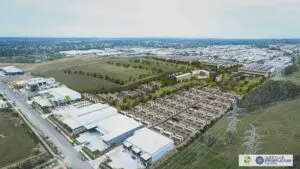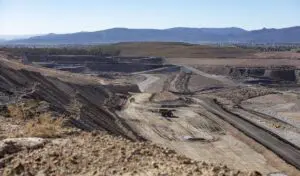The first large scale solar battery hybrid power plant in Australia is feeding power into the grid well after sunset, helping to meet demand surges in the evening peaks, and addressing the question of what supplies power when the sun don’t shine.
The 128 MW Cunderdin solar farm, with a “DC-coupled” 55 MW/220 MWh battery, was formally opened by the Spanish company GPG earlier this month, but is already providing a significant amounts of power well into the evening peak in Western Australia, as the graph below illustrates.
There are already a number of solar farms with adjacent big batteries in Australia (Gannawarra, Western Downs) and others on their way, but these usually have separate connection points, meaning that the solar output fades as the sun goes down, and the battery operates as a separate entity.
DC-coupled projects like Cunderdin, and Fulham in Victoria that is now being built, means that the solar farm and the big battery share the same connection point.
That means that the facility is viewed by the market operator as a solar facility, even though it sends power into the grid well into the evening, and is even capable of doing so overnight, albeit at lower quantities.
But it is the evening peak, when prices are high, that GPG is targeting at Cunderdin, and it is happy to store some of the output that might otherwise be curtailed, or sold at very low prices, in the middle of the day and keep it for use when the prices are higher in the evening.
“This hybrid system is designed to provide a four-hour constant power supply during peak demand periods every day of the year,” the company said in a recent LinkedIn post celebrating its opening.

Ray Wills, the chair of the developer Sun Bred Power, which initially developed the project and sold it to GPG in July 2022 just before construction started, says it is a significant milestone as Australia’s first large-scale hybrid solar-battery facility.
“This innovative project combines solar generation with battery storage, enabling the efficient use of renewable energy beyond daylight hours,” he says.
Recent production data for the facility shows the spread of solar output by batteries very clearly. As the graph above illustrates – it was sent in by Wills – the 220 MWh of battery provides steady supply into the evening each day, supplying during peak demand and enhancing grid flexibility
(See Renew Economy’s explainer on this: Explainer: What does it actually mean to “firm” renewables?
Wills says the direct DC coupling of the solar panels to the battery improves operational efficiency and reduces costs compared to traditional AC-coupled systems.
It’s just a taste of what is to come. Major renewable investors such as Quinbrook Infrastructure say that pairing vast solar arrays with up to eight hours of storage will underpin new green industries, including energy intensive ones, because no other technology can compete on costs.
Solar costs have resumed their fall, after a brief inflationary spike after the Russian invasion of Ukraine, and battery storage costs are plunging rapidly. Quinbrook has plans for at least half a dozen such facilities in the eastern states and the Norther Territory, where it is also working on the massive Sun Cable project.
Mining giant Rio Tinto is also looking at large scale solar paired with battery storage – in its case four hours of storage (although energy experts point out that a battery can easily be eight hours if the output is dialled back) – and says the combination is essential for the future of its aluminium smelters and refineries.
It is important to remember that large scale solar farms are a relatively new addition to Australia’s electricity grid – the first was built in Western Australia in 2012 (at Greenough River in WA), and the first to be built on Australia’s main grid in the eastern states (Royalla in the ACT) was not connected until late 2014.
These first solar farms were based on fixed tilt mountings, and the first solar farm with single axis tracking technology – which allows panels to follow the sun from dawn to dusk, lengthening the amount of time it can produce power – was built at Moree in 2016.
Now, virtually all solar farms use single axis tracking, as well as bifacial panels (panels that also collect energy of the back side of the module through reflection) and will now likely move into paired storage.
Wills says one technical issue that has emerged is the metering issue and definitions which can be confusing to observers. Cunderdin is categorised as a solar farm, but when it is producing power after the sun has set it is clearly the battery at work.
“If Cunderdin’s battery contribution were included in WA’s grid consumption statistics, it would lift WA battery share of grid consumption from 8.2% to 9.8% at 6pm on April 11,” he notes.
“Hybrid DC-coupled systems with lower operating costs will no doubt drive further adoption of similar configurations like Cunderdin, but better integration of batteries into AEMO reporting frameworks will be essential for accurate energy market insights.
“The true contribution of battery facilities won’t be captured as more plants hybridise, and [will] make following the growth of battery storage in the SWIS (the main grid in WA), and elsewhere, harder to assess. Regulatory and reporting mechanisms must evolve with new innovations in renewable energy systems.”








